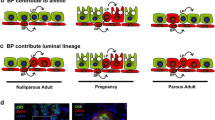In female Wistar rats, mammary gland hyperplasia (MGH) was modeled according to a modified protocol involving estrogen-progesterone induction and taking into account the duration of the estrous cycle of this animal species. MGH was induced over four 7-day cycles; each cycle included subcutaneous administration of 17β-estradiol (0.5 mg/kg) for 4 days, injection of progesterone (5 mg/kg) on day 5, then 2 days without injections. In females with MGH, a significant increase in the height and diameter of the nipples of the mammary glands was recorded, two types of changes were observed in the gland tissue: tubuloalveolar and lobuloalveolar hyperplasia. The study confirmed the development of MGH in rats by a modified method.
Similar content being viewed by others
References
Gynecology. Radzinsiy VE, Fuks AM, eds. Moscow, 2016. Russian.
Bespalov VG, Kovalevskaya EI. Modern conceptions of etiology and pathogenesis of benign breast disease: the possibilities of pathogenetic treatment. Ginekologiya. 2019;21(1):52-58. Russian. https://doi.org/10.26442/20795696.2019.1.190217
Stachs A, Stubert J, Reimer T, Hartmann S. Benign breast disease in women. Dtsch Arztebl Int. 2019;116(33-34):565-574. https://doi.org/10.3238/arztebl.2019.0565
Semiglazov VV, Ailamazyan EK, Bailyuk YeN, Niauri DA, Ivanov VG, Manikhas AG, Kvetnoi IM, Soshnev AA. Prophylaxis of breast cancer in patients with reproductive system hyperproliferative pathologies. Vopr. Onkol. 2006;52(3):247-257. Russian.
Bernstein LM. Oncoendocrinology: Tradition, Modernity, and Perspectives. St. Petersburg, 2004. Russian.
Walters KA, Allan CM, Handelsman DJ. Rodent models for human polycystic ovary syndrome. Biol. Reprod. 2012;86(5):149, 1-12. https://doi.org/10.1095/biolreprod.111.097808
Wang F, Ma Z, Wang F, Fu Q, Fang Y, Zhang Q, Gao D, Li Y, Li L, Yu L, Yu Z. Establishment of novel rat models for premalignant breast disease. Chin Med. J. (Engl). 2014;127(11):2147-2152.
Chang XJ, Zhou J, Zhang S, Chen J, Chen CM, Wang ZZ, Xiao W. Effects of guizhi fuling capsule on sex hormone levels and breast issue morphology of mammary gland hyperplasia model rats. Zhongguo Zhong Yao Za Zhi. 2014;39(21):4139-4142.
Sun L, Guo DH, Liu F, Liu Q, Jiang N, Sun YF, Cai LP, Zheng HX. A mouse model of mammary hyperplasia induced by oral hormone administration. Afr. J. Tradit. Complement. Altern. Med. 2017;14(4):247-252. https://doi.org/10.21010/ajtcam.v14i4.27
Li X, Wang Z, Wang Y, Zhang Y, Lei X, Xin P, Fu X, Gao N, Sun Y, Wang Y, Yang B, Wang Q, Kuang H. Anti-hyperplasia effects of total saponins from phytolaccae radix in rats with mammary gland hyperplasia via inhibition of proliferation and induction of apoptosis. Front. Pharmacol. 2018;9:467. https://doi.org/10.3389/fphar.2018.00467
Zhang JF, Liu J, Gong GH, Zhang B, Wei CX. Mongolian medicine ruxian-i treatment of estrogen-induced mammary gland hyperplasia in rats related to TCTP regulating apoptosis. Evid. Based Complement. Alternat. Med. 2019;2019:1907263. https://doi.org/10.1155/2019/1907263
Anisimova SA, Svirina ZA, Maksaev DA. Modeling of fibrocystic mastopathy in experiment on animals. Ross. Med. Biol. Vestn. 2020;28(4):429-436. Russian. https://doi.org/10.23888/PAVLOVJ2020284429-436
Yoshida M, Sanbuissyo A, Hisada S, Takahashi M, Ohno Y, Nishikawa A. Morphological characterization of the ovary under normal cycling in rats and its viewpoints of ovarian toxicity detection. J. Toxicol. Sci. 2009;34(Suppl. 1):SP189-SP197. https://doi.org/10.2131/jts.34.s189
Pavithra V, Sathisha TG, Kasturi K, Mallika DS, Amos SJ, Ragunatha S. Serum levels of metal ions in female patients with breast cancer. J. Clin. Diagn. Res. 2015;9(1):BC25-c27. https://doi.org/10.7860/JCDR/2015/11627.5476
Liu J, Zhang JF, Gong GH, Zhang B, Wei CX. Therapeutic effect of Mongolian medicine ruxian-i on hyperplasia of mammary gland induced by estrogen/progesterone through CRYAB-promoted apoptosis. Evid. Based Complement. Alternat. Med. 2020;2020:5707106. https://doi.org/10.1155/2020/5707106
Author information
Authors and Affiliations
Corresponding author
Additional information
Translated from Byulleten’ Eksperimental’noi Biologii i Meditsiny, Vol. 175, No. 1, pp. 128-132, January, 2023
Rights and permissions
Springer Nature or its licensor (e.g. a society or other partner) holds exclusive rights to this article under a publishing agreement with the author(s) or other rightsholder(s); author self-archiving of the accepted manuscript version of this article is solely governed by the terms of such publishing agreement and applicable law.
About this article
Cite this article
Semenov, A.L., Tyndyk, M.L., Von, Y. et al. Modified Estrogen-Progesterone Induction Method of Mammary Gland Hyperplasia in Rats. Bull Exp Biol Med 175, 112–115 (2023). https://doi.org/10.1007/s10517-023-05821-2
Received:
Published:
Issue Date:
DOI: https://doi.org/10.1007/s10517-023-05821-2




